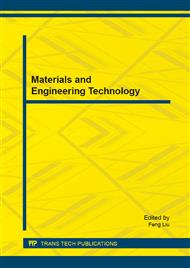[1]
Ureten O., Serinken N.: Wireless security through RF fingerprinting. Canadian Journal of Electrical and Computer Engineering, vol. 32, no. 1, pp.27-33(2007).
DOI: 10.1109/cjece.2007.364330
Google Scholar
[2]
Crystal B., Kevin R., Brya N., Mark H.: Wavelet Fingerprinting of Radio-Frequency Identification (RFID) Tags. IEEE Transactions on Industrial Electronics , vol. 59, no. 12, pp.4843-4850 (2012).
DOI: 10.1109/tie.2011.2179276
Google Scholar
[3]
Afolabi O., Kim K., Ahmad A.: On Secure Spectrum Sensing in Cognitive Radio Networks Using Emitters Electromagnetic Signature. In: IEEE Proceedings of 18th International Conference on Computer Communications and Networks, San Francisco, California, pp.1-5. IEEE Press, New York (2009).
DOI: 10.1109/icccn.2009.5235288
Google Scholar
[4]
Reising D. R., Temple M. A., Mendenhall M. J.: Improving intra-cellular security using air monitoring with RF fingerprints. In: IEEE Wireless Communications and Networking Conference (WCNC), pp.1-6 . IEEE Press, New York (2010).
DOI: 10.1109/wcnc.2010.5506229
Google Scholar
[5]
Polak A., Dolatshahi S., Goeckel D.: Identifying wireless users via transmitter imperfections. IEEE Journal on Selected Areas in Communications, vol. 29, no. 7, pp.1469-1479(2011).
DOI: 10.1109/jsac.2011.110812
Google Scholar
[6]
Saeed U. R., Kevin S., Colin C.: RF Fingerprint Extraction from the Energy Envelope of an Instantaneous Transient Signal. IEEE Communications Theory Workshop, Australian, pp.90-95 (2012).
DOI: 10.1109/ausctw.2012.6164912
Google Scholar
[7]
Ellis K., Serinken N.: Characteristics of radio transmitter fingerprints. Journal of Radio Science, vol. 36, no. 4, pp.585-597(2001).
DOI: 10.1029/2000rs002345
Google Scholar
[8]
Shaw D., Kinsner W.: Multi-fractal Modeling of Radio Transmitter Transients for Classification. In: Proceedings Conference on Communications, Power and Computing, pp.306-312 (1997).
DOI: 10.1109/wescan.1997.627159
Google Scholar
[9]
Klein R.W., Temple M.A., Mendenhall M. J.: Application of Wavelet Denoising to Improve OFDM-Based Signal Detection and Classification. Journal on Security and Communication Networks, Special Issue: Security in Next Generation Wireless Networks, vol. 2, no. 6, pp.71-82 (2009).
DOI: 10.1002/sec.115
Google Scholar
[10]
Klein R.W., Temple M.A., Mendenhall M. J.: Application of Wavelet-Based RF Fingerprinting to Enhance Wireless Network Security. Journal on Communication Networks, Special Issue: Secure Wireless Networking, vol. 11, no. 6, pp.544-555 (2009).
DOI: 10.1109/jcn.2009.6388408
Google Scholar
[11]
IRWIN O. Kennedy, MILIND M. Buddhikot, Nolan Keith E.: Radio Transmitter Fingerprinting: A Steady State Frequency Domain Approach. In: IEEE 68th Vehicular Technology Conference, pp.1-5, IEEE Press, New York (2008).
DOI: 10.1109/vetecf.2008.291
Google Scholar
[12]
Dominique S., Mairtin O., Anthony A. G.: RF Power Amplifier Behavioral Modeling. Cambridge University Press , London, pp.35-44 (2009).
Google Scholar
[13]
Swami A., Giannakis G.: Multichannel ARMA Processes. IEEE Transactions on Signal Processing, vol. 42, no. 4, pp.898-913 (1994).
DOI: 10.1109/78.285653
Google Scholar
[14]
Leonov V. P., Shiryaev A. N.: On the Technique of Computing Semi-Invariants. Theory of Probability Applications, vol. 4, pp.319-329 (1959).
Google Scholar
[15]
Liu C., Gabor-based kernel PCA with fractional power polynomial models for face recognition. IEEE Transactions on Pattern Analysis and Machine Intelligence, vol. 26, No. 5, pp.57-581 (2004).
DOI: 10.1109/tpami.2004.1273927
Google Scholar
[16]
Marco S., Lieven D. L., Johan A. K. S.: A kernel-based framework to tensorial data analysis. Neural Networks, vol. 24, no. 8, pp.861-874 (2011).
DOI: 10.1016/j.neunet.2011.05.011
Google Scholar
[17]
[Online] http: /www. crawdad. org/, (2008).
Google Scholar


